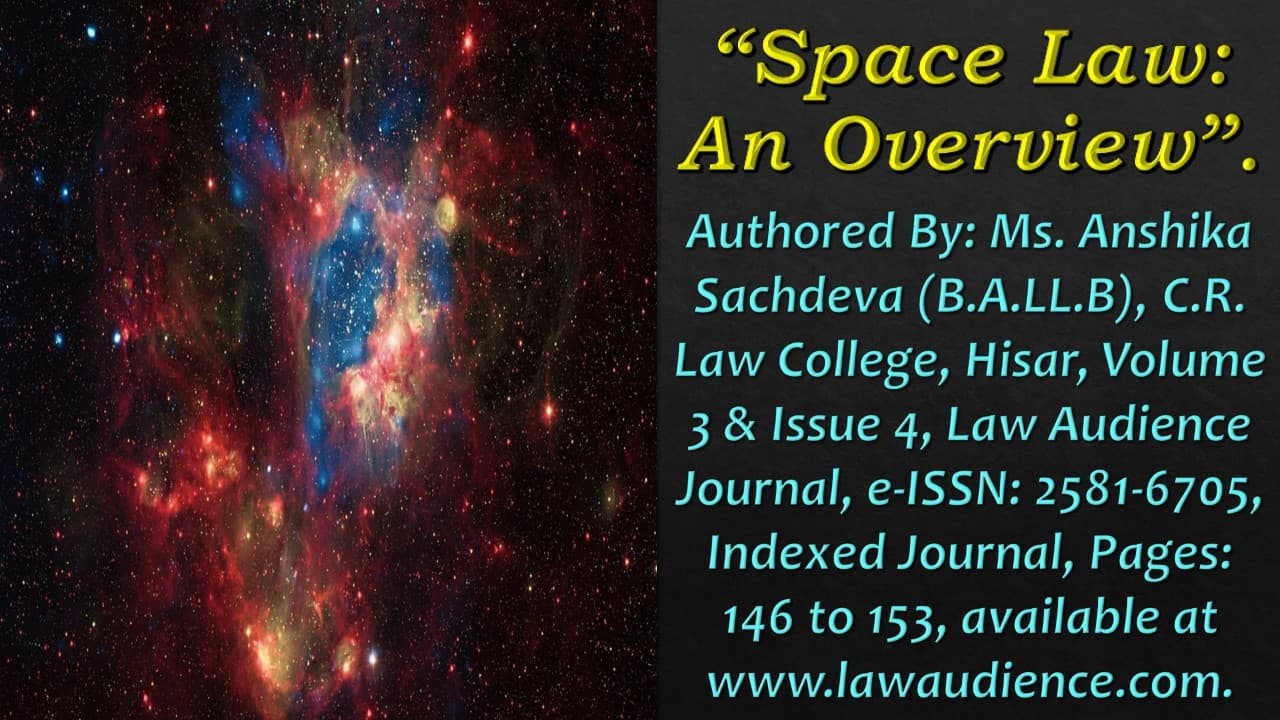Click here to download the full paper (PDF)
Authored By: Ms. Anshika Sachdeva (B.A.LL.B), C.R. Law College, Hisar,
Click here for Copyright Policy.
I. INTRODUCTION:
“In today’s world, as with the increase in the modern technology in all sphere of lives, our daily life activities cannot be carried out without the use of technology and for the same it is important that we should have the knowledge of the space law as all the different technology would play no part if we are not able to use the space. Space law is defined as the international law that covers the aspects of outer space and regulates the relations of the states with one another and also with other organisations related to various space activities. Space law provides a keen knowledge of outer space which help in governing various space related activities”.
II. USES:
- Increase in economic opportunities.
- Helps in environment preservations.
- Observation of earth for weather forecast and climate related news.
- Increase in space-based Positioning, Navigation and Timing services.
- Helps in governing everyday life activities like solar panels, water purification system, information sharing etc.
III. SATELLITE NAVIGATION:
Satellite navigation is the most significant and important technological development of century which depends on the principle of PNT (positioning, navigation and timing). Earlier, the Global Navigation Satellite System is used only for the military authorities but nowadays it is mostly used by the civilians. The provisions of global navigation are based on the national law of the countries because due to the controversies, the countries failed to formulate a legally binding act. Satellite navigation depends on the various international space law treaties like Outer space Treaty, UN Charter, International civil Aviation Convention ( ICAC ) etc.
The different principles which form the keystone for formation of satellite navigation are:
- Outer Space Treaty (Article 1):
It provides that all the states have free access to outer space without any kind of discrimination and the same we carried out for the benefit of all the countries irrespective of their degree of economic or scientific development.
- ICAO:
All the states have access to global navigation satellite services on a non-discriminatory basis.
- UN (Article 2):
GNSS satellites shall be registered in their respective state.
Satellite navigation is constantly being evolved and it is anticipated that they will increase to develop in near future.
IV. DEVELOPMENT OF SPACE LAW:
Development of space have actually started when Russia launched its first satellite Sputnik on October 4, 1957.
The development of space law can be traced in 3 different phrases and that is:
- Phrase 1 – Evolution of space law before Sputnik (1910 – 1957);
- Phrase 2 – Explanation and adoption of fundamental applicable laws (1957 – 1966);
- Phrase 3 – Growth of space-related activities and the legal issues arousing out of them (21st century);
With the start of the evolution of space law only a handful of papers and one monograph was present which states the concept of space law. It was the discovery of Sputnik by Russia in 1957 that the laws relating to space law were established. After the discovery of Sputnik, an international Declaration was adopted in form of UN General Assembly Resolution and referred to “The Declaration of Legal Principles Governing the Activities of States in Exploration and Use of Outer space”.
Later in 1967, this declaration was named as The Outer Space Treaty. Various rules governing the space activities are :
- All states can use and explore the outer space
- Exploration is done for the benefit of humans.
- State is responsible for their outer space activities.
- Launching state owns the right of ownership the objects launched in outer space etc.
V. SHIFT FROM AIR LAW TO SPACE LAW:
The shift from air law to space law is carried out in 2 heads, i.e.,
- Emergence of Air Law:
Earlier, when there was no modern technology, humans have excess to their land and territorial jurisdiction without the knowledge of air but with advancement of technology, humans started exploring the air above them results in the discovery of many new products like hot air balloon, aircraft etc. But, to regulate air activity a Chicago Convention convey certain principles like they started that every state has complete sovereignty of in airspace above its territory. Later, various other convention for airspace were carried out.
- Need for Space Law:
As human exploration of airspace increased step by step resulting in making international law for space activities. In 1926, professionals started that there is an upper limit to state’s sovereignty and a separate government is required to deal with the area above this upper limit.
But there is no accurate answer as to where the airspace ended and outer space started.
VI. FREEDOM OF EXPLORATION AND USES:
The basic principle of outer space law is to provide freedom to all states for the exploration and use of space. Exploration here means to do scientific activities to open up the mystery of universe. As, all the states have freedom to explore and use outer space but they don’t have right to restraint any other state to do so, i.e., any state must not place any obstacle in another state’s way in conducting their activities.
VI.I WHO CAN EXERCISE FREEDOM OF EXPLORATION?
According to the outer space treaty, all countries including all international organisations, non-government and citizens of any state have right to explore the outer space, moon and other celestial bodies.
VI.II “ALL” COUNTRIES:
The exploration and use of outer space are for the benefit and interest of all the states making it a province of all mankind and resulting in non-discrimination.
VI.III BENEFITS AND INTEREST:
As the exploration and use of outer space are carried out for the benefit and interest of all mankind, benefit here means advantage and interest means pattern of demand and its supporting expectations. Now, as many states and organisations are using outer space, a pragmatic approach should be adopted by state in order to ensure sustainable use of outer space.
VII. OUTER SPACE TREATY:
The outer space treaty can be named as the Magma Carta of space law. It is the second non-armament treaty that has evolved as the fundamental treaty of outer space. The main principles and details of outer space treaty are based on the Antarctica treaty. The then president Eisenhower of western proposed the development of mechanisms for space law for partial disarmament and also suggested to apply the principle of Antarctica treaty. The main aim of the outer space treaty is to explore the universe and other celestial bodies on the basis of equality and command interest. The treaty also provide that the exploration of outer space is done for the benefit of mankind and is carried out by any state irrespective of their social, economic or political conditions.
The various provisions of outer space treaty are :
- Outer space comprises the moon and other celestial bodies which don’t come under any national jurisdiction as the space is beyond the jurisdiction of any state.
- All the countries including international organisations, non-government bodies and citizens of any state have right to explore the outer space, the moon and all other celestial bodies.
- The responsibility of space activities shall be carried out by the launching state.
- To have jurisdiction over space objects, the launching state must have the registration of the same.
As the outer space treaty talks about the responsibility of countries for national action and provides liability of the state for damage caused towards others, the responsibilities and liabilities are :
VII.I LIABILITY:
Liability can be defined as the state of being legally responsible for something. Liability is closely related to damage. A wrongful act can lead to damage and thus, damage leads us to provide liability to the state causing damage. A-7 of OST provides that each party that launches an into outer space is internationally liable to another party who has caused any damage. This article also gave rise to Liability Convention, 1972 which provide two different kinds of liability, i.e.,
- Absolute Liability: Liability in which launching state is absolutely liable for damage caused by its space object on the surface of earth or aircraft flight.
- Fault Liability: Liability in which the damage is caused elsewhere than on the surface of the earth of one launching state to person or property by space objects of another launching state and the same is liable only if the damage is due to its fault.
VII.II RESPONSIBILITY:
Responsibility can be defined as the fact of having a duty to deal with something or having control over someone. The treaty provides that the state party shall bear international responsibility for activities in outer space either carried out by government agencies or non-government agencies. In the case where more than one state has jurisdiction over space object, then, the concept of concurrent jurisdiction will apply.
VIII. PRIVATE SPACE ACTIVITIES:
After the discovery of Sputnik 1957, there is a rapid growth in exploration and use of outer space. One of the most important helping hands in such advancement is commercially feasible technologies and improved business methods. But today, the outer space activities are not confined for the use of mere nation-state but also by private companies. Private companies are providing funds in space tourism, lunar mining etc giving rise to proper living conditions on the moon and mars. The growth of private space companies in the production for space products and services helps in assisting the governmental agencies in using their resources in a systematic way helping to create the next generation advanced technologies and applications.
The major help provided by private entities is in the form of financing like :
- Asset-Based Financing:
It is defined as a specialized method of providing companies with working capital and term loans that use accounts receivable, inventory, machinery, equipment or real estate as collateral.
In order to grow and become a profitable business, an enterprise need to spend capital on numerous requirements which means that enterprise has to borrow money from available sources and the same opportunity is provided by asset-based financing.
In asset-based financing, in case of default by the debtor, the creditor is empowered to enforce its rights against equipment. However, there is no law governing the location of equipment in outer space resulting in a situation making the risk of asset-based financing less acceptable.
- UNIDROIT Convention and Draft Space Protocol:
The United Nations International Institute for Unification of Private Law (UNIDROIT), took the initiative to formulate a uniform regulatory system for recognition and safeguarding the security interest in space asset. UNIDROIT Convention has opened for signature on 16 November 2001 in a conference held in Cape Town. UNIDROIT Convention was marked as an important step in harmonizing and bringing together the rules of national law.
IX. INDIAN LAWS ON SPACE ACTIVITIES:
The launch of Sputnik in 1957 marked the inception of exploration in space resulting in an investment of the huge amount of money by developed and developing countries in order to explore, control and govern the outer space. But there was a need for national laws not only for international relations but also for the smooth and uniform conduct of parties. Also, the states are usually required to enact national legislation so that they can regulate their activities in the way they see most suitable and also protect the interests and rights of its citizens.
IX.I DEPARTMENT OF SPACE (DoS):
The department responsible for the administration of the Indian space program is DoS. Its main objective is to encourage the advancement and use of space science and technology for the advantage of the country.
DoS contains two chief satellite system:
- INSAT – use for communication, television broadcasting and meteorological services.
- IRS – use for resource management and monitoring.
There are many agencies and institute which are managed by DoS but the most important organisation managed by DoS is ISRO.
IX.II ISRO (INDIAN SPACE RESEARCH ORGANISATION):
The sixth-largest Organisation, ISRO was founded in 1969 with an aim in the progress of various sectors like agriculture, defence, communication and education.
Objectives:
- Operational flights of Polar Satellite Launch Vehicle;
- Developmental flights of Geosynchronous Satellite Launch Vehicle;
- Promotion of space technology;
- Training, Capacity building and education;
- International Cooperation;
- Earth observation applications etc;
X. PROTECTION OF SPACE ENVIRONMENT:
Humans, having a keen tendency to explore and use new aspects of life makes it different from other living creatures on Earth. As they have explored the Earth, now their next step is towards outer space. However, the exploration and development of humans and human-made activities on Earth-like industries, tourism and commerce have shown the ability and level of exploration humans can do but it also shows the amount of exploitation which can be caused by such exploration and which would strongly explain the amount of exploitation which can be caused to outer space only due to the desire and longing of humans.
This explanation and capabilities of mankind have forced the need for protection of the outer space environment which further helps in protecting and conserving space environment. As we expand our influence into the solar system, conserving space environment has become a question of concern for many scientists. Some suggest the method of degradation while others support the theory of slash and burn. Also, many have opted to choose a blind eye on pollution and degradation event in favour of budget, project and personnel advancement. However, there is no time like the present to be serious and prepare ourselves for the protection of our space environment.
Cite this article as:
Ms. Anshika Sachdeva, “Space Law: An Overview”, Vol.3 & Issue 4, Law Audience Journal (e-ISSN: 2581-6705), Pages 146 to 153 (15th March 2022), available at https://www.lawaudience.com/space-law-an-overview/.
Footnotes & References:
- Lexlife India Space law internship;
- https://www.google.com/url?sa=t&source=web&rct=j&url=https://en.m.wikipedia.org/wiki/Space_law&ved=2ahUKEwiXrpmoiujrAhXDTX0KHQyRBOsQFjAfegQIAhAB&usg=AOvVaw2xU18qBgd62l-KM1jbPoay;




